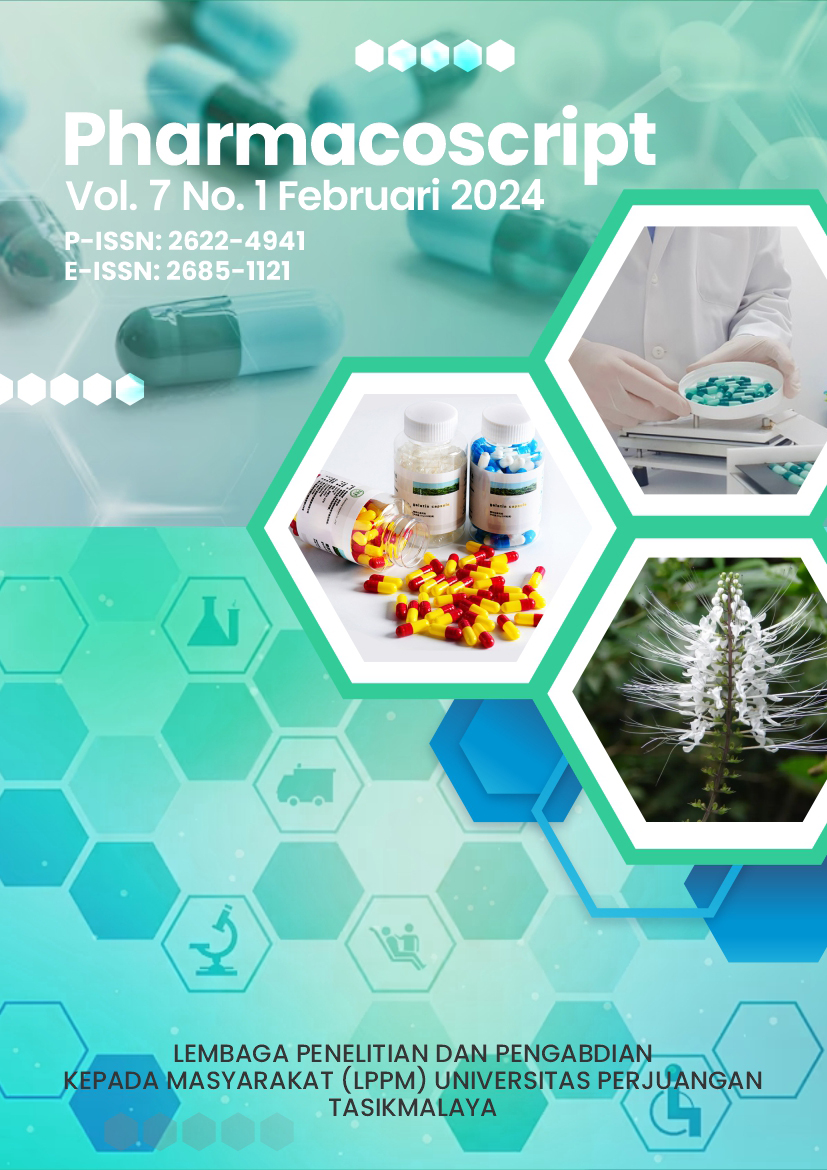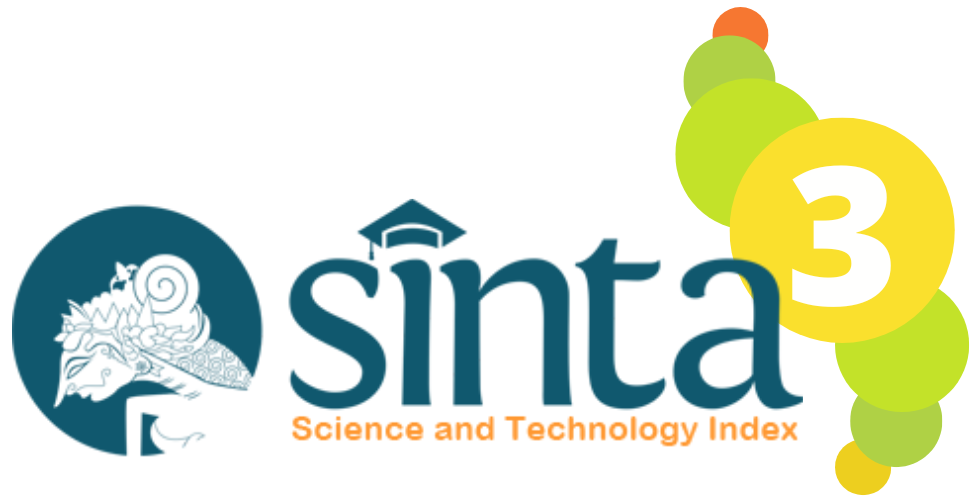AKTIVITAS HEPATOPROTEKTOR KOMBINASI RIMPANG TEMULAWAK (Curcuma xanthorriza Roxb.) DENGAN BUAH LADA HITAM (Piper nigri L.) PADA TIKUS WISTAR
DOI:
https://doi.org/10.36423/pharmacoscript.v7i1.1589Keywords:
Hepatoprotektor, Rifampisin, INH, Curcuma xanthorriza Roxb, Piper nigri L.Abstract
Temulawak (Curcuma xanthorriza Roxb.) merupakan tanaman tradisional dengan kandungan utamanya adalah kurkuminoid yang berkhasiat hepatoprotektor. Penyerapan kurkuminoid yang buruk dapat ditingkatkan dengan piperin. Penelitian ini bertujuan untuk menguji efek hepatoprotektor kombinasi rimpang temulawak dengan buah lada hitam dalam bentuk kapsul yang terdiri dari temulawak/lada hitam (1520mg/40mg). Efek hepatoprotektor diuji pada tikus Wistar jantan yang diinduksi kerusakan hati dengan obat TB (isoniazid dan rifampisin). Dua dosis kombinasi yang diuji yaitu ekivalen dengan 2 Kapsul temulawak/lada hitam (TLH1) dan 3 kapsul temulawak/lada hitam (TLH2) masing-masing kombinasi simplisia uji tersebut. Hasil menunjukkan temulawak dan kombinasinya (TLH1 dan TLH2) mulai mencegah kerusakan hati pada pemberian hari ke-14 yang terlihat dari aktivitas ALT. Dilihat dari kadar albumin, temulawak maupun kombinasinya dapat memperbaiki kerusakan hati mulai hari ke-7 pemberian. Secara umum kombinasi lebih berpotensi mencegah dan mengobati kerusakan hati dibandingkan tanpa kombinasi.
References
Bishnoi, M., Chopra, K., Rongzhu, L., & Kulkarni, S. K. (2011). Protective effect of curcumin and its combination with piperine (bioavailability enhancer) against haloperidol-associated neurotoxicity: Cellular and neurochemical evidence. Neurotoxicity Research, 20(3), 215–225. https://doi.org/10.1007/s12640-010-9229-4
Devaraj, S., Ismail, S., Ramanathan, S., Marimuthu, S., & Fei, Y. M. (2010). Evaluation of the hepatoprotective activity of standardized ethanolic extract of Curcuma xanthorrhiza Roxb. Journal of Medicinal Plants Research, 4(23), 2512–2517. https://doi.org/10.5897/jmpr10.453
Khan, H., Ullah, H., & Nabavi, S. M. (2019). Mechanistic insights of hepatoprotective effects of curcumin: Therapeutic updates and future prospects. Food and Chemical Toxicology, 124, 182–191. https://doi.org/10.1016/j.fct.2018.12.002
Llano, S., Gómez, S., Londoño, J., & Restrepo, A. (2019). Antioxidant activity of curcuminoids. Physical Chemistry Chemical Physics, 21(7), 3752–3760. https://doi.org/10.1039/c8cp06708b
Pal, R., Vaiphei, K., Sikander, A., Singh, K., & Rana, S. V. (2006). Effect of garlic on isoniazid and rifampicin-induced hepatic injury in rats. World Journal of Gastroenterology, 12(4), 636–639. https://doi.org/10.3748/wjg.v12.i4.636
Shivarkar R, S. Bhise, M. G. (2021). Antituberculor activity of Curcuminoids isolated from Curcuma longa Rhizomes. 13(01), 5958. https://doi.org/10.5958/0975-4385.2021.00002.9
Sirisidthi, K., Kosai, P., Jiraungkoorskul, K., & Jiraungkoorskul, W. (2016). Antithrombotic activity of turmeric (Curcuma longa): A review. Indian Journal of Agricultural Research, 50(2), 101–106. https://doi.org/10.18805/ijare.v50i2.9586
Wiendarlina, I. Y., Rahminiwati, M., & Gumelar, F. T. (2019). AKTIFITAS HEPATOPROTEKTOR EKSTRAK AIR HERBA PEGAGAN DAUN KECIL (Centella asiatica L. Urb.) TERHADAP TIKUS PUTIH JANTAN Sprague Dawley L. YANG DIINDUKSI DENGAN PARASETAMOL. FITOFARMAKA: Jurnal Ilmiah Farmasi, 8(1), 12–22. https://doi.org/10.33751/jf.v8i1.1167
Yue, J., Peng, R., Chen, J., Liu, Y., & Dong, G. (2009). Effects of rifampin on CYP2E1-dependent hepatotoxicity of isoniazid in rats. Pharmacological Research, 59(2), 112–119. https://doi.org/10.1016/j.phrs.2008.10.006
Downloads
Published
Issue
Section
License
Copyright (c) 2024 Mochamad Herdi Nurzaman, Adila Awaludin, Salsabila Adlina

This work is licensed under a Creative Commons Attribution-ShareAlike 4.0 International License.
Authors who publish with this journal agree to the following terms:
- Authors retain copyright and grant the journal right of first publication, with the work [SPECIFY PERIOD OF TIME] after publication simultaneously licensed under a Creative Commons Attribution License that allows others to share the work with an acknowledgement of the work's authorship and initial publication in this journal.
- Authors are able to enter into separate, additional contractual arrangements for the non-exclusive distribution of the journal's published version of the work (e.g., post it to an institutional repository or publish it in a book), with an acknowledgement of its initial publication in this journal.
- Authors are permitted and encouraged to post their work online (e.g., in institutional repositories or on their website) prior to and during the submission process, as it can lead to productive exchanges, as well as earlier and greater citation of published work (See The Effect of Open Access).









